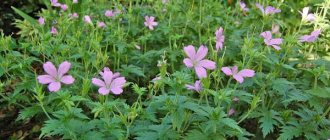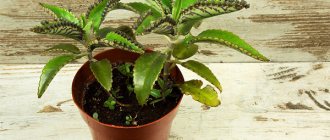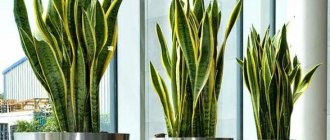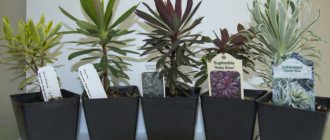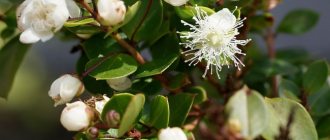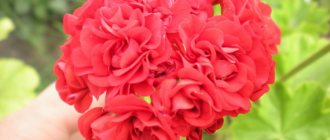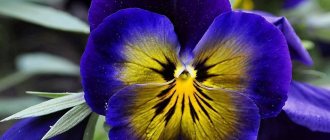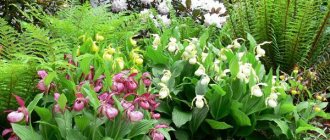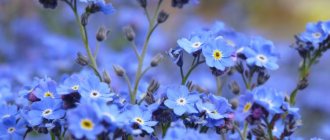Forest geranium, photo and description of the plant
In forest geraniums, the rhizome is located vertically or at a slight angle in relation to the stem. In the upper part it is thicker, with remnants of basal leaves. Ribbed, erect stems grow up to 80 cm. Small hairs cover their entire length. The basal leaves are collected in a rosette. They can be either five-partitioned or seven-partitioned. The length of their petioles is about 30 cm. The size of the middle stem leaves is smaller. They are five-parted, the petioles are much shorter. The upper leaves of geranium are opposite, most often tripartite, almost sessile.
You can see what forest geranium looks like in the photo. Geranium flowers are relatively large, purple or violet in color, arranged two on one peduncle. The inflorescence is a multi-flowered dichasia. The plant blooms in June. The first fruits begin to ripen in early August. Their shape resembles a bird's beak.
Forest geranium can be found in coniferous and mixed forests, next to shrubs. The plant prefers fertile, humus-rich soils.
Description chemical composition
Meadow geranium, Geranium pratense L. has an oblique rhizome up to 10 cm long, one or more erect, covered with stiff hairs, stems 20 - 80 cm high, branched in the upper part, with numerous basal long-petiolate seven-part leaves, consisting of seven pinnately incised lobes , 6 - 7 cm long. The leaves on the stems are five-parted, the upper ones are sessile three-parted.
Numerous flowers are collected in corymbose inflorescences, on each peduncle there are 2 flowers with 5 bright lilac-blue or violet-blue petals about 2 cm long, peduncles and sepals are pubescent. It blooms in June - August, that is, all summer, the fruits ripen in July - September, and is distributed mainly by seeds.
For medicinal purposes, the above-ground part is used - grass and rhizomes with roots. The grass is collected during flowering, dried in the open air under a canopy, in ventilated rooms or dryers at a temperature of 40÷45°C. Store raw materials for 1 year. The roots are dug up in the fall, washed, withered and dried.
All parts of the plant contain many tannins, carbohydrates, saponins, flavonoids, ascorbic acid and carotene. Rhizomes and roots contain up to 38% tannins. The aerial part contains alkaloids, anthocyanins, and minerals: iron, manganese, nickel, zinc.
The scientific name Geranium is derived from the Greek word geranos - crane; the upper part of the ovary of the fruit - a box with sepals - elongates when ripe and resembles the beak of a crane, which is where the name comes from. The specific name pratense in translation means meadow and characterizes the place of growth.
Forest geranium and the content of nutrients in it
The chemical composition of a plant can vary depending on the type and place of growth, not only in quantitative but also qualitative terms.
The root system of forest geranium synthesizes:
- various tannins, the content of which can reach up to 22%;
- alkaloids;
- starch;
- acids and their salts.
The above-ground part of the plant contains vitamin C, as well as sucrose, fructose, glucose, flavonoids and gallotannins and ellagitannins. Forest geranium seeds contain leukocyanides, due to which they exhibit antioxidant properties. The vegetative mass of wild geranium species accumulates various microelements - copper, manganese, nickel, zinc.
Geraniol is one of the components of geranium essential oil and is widely used in the perfume industry.
Popular varieties and photos with them
Of the entire variety of geraniums, the following most popular types can be distinguished. You can also see how the flowers look in the photo.
Album
It is distinguished by long and lush flowering, the highest decorative effect, thanks to which it can decorate shady corners of the garden;
Mayflower
The flowers of the variety have a bluish color with a slight lilac tint, but its core is lighter than the edges of the corolla.
Medicinal properties of forest geranium
Wild geranium is harvested during the flowering period. Dry the collected plants in the shade, in the open air or under the roof, in the attic. If the grass does not hang in bunches, it must be mixed. The shelf life of dry raw materials is 2 years. The roots of some species can also be used as medicinal raw materials. They are dug in late autumn, after the upper part of the plant has died off.
Homemade pelargonium leaves are used fresh. Since this plant does not have a clear dormant period, raw materials can be collected at any time of the year.
Most types of geranium have remarkable medicinal properties. The plant contains essential oil, which is why it has such a memorable smell, but not as strong as its indoor counterpart. The most “outstanding” aroma is that of Robert’s geranium, which is popularly called “stinker”.
The above-ground part of forest geranium is mainly used as a medicinal product; rhizomes are used less frequently. Traditional healers have recommended many ways to obtain healing tinctures and decoctions, all kinds of rubs and oils. Infusions have disinfectant and antibacterial properties. With their help, they treat throat diseases - sore throat, tonsillitis, pharyngitis. The astringent properties of geranium are used to treat diseases of the gastrointestinal tract. Most often, medicinal raw materials in folk medicine are necessary for the preparation of external remedies. They are very effective in stopping bleeding in various skin lesions, cuts, abrasions, and wounds. They also reduce pain from bruises and soothe itching.
How to properly care?
Watering
Forest geranium can grow in regions with warm climates , so the flower tolerates drought well. It is not recommended to over-moisten the soil, otherwise the roots will rot. Use settled water for irrigation. Spraying is not recommended, as this will harm the velvety leaves of the plant.
Fertilizer and feeding
A flower can grow in the same soil for 2 years, but during this time the soil is depleted, washed away and loses nutrients. To achieve abundant flowering of geraniums, it is necessary to use fertilizers.
The plant responds positively to compounds containing phosphorus . Apply them during the formation of buds and during flowering. In early spring and before flowering, it is advisable to feed geraniums with nitrogen-containing preparations. You can add organic matter throughout the summer.
To feed geraniums, you can use homemade formulations. It is very effective to apply fertilizer made from sugar. You need to take 20 g of the product and dilute it in 1 liter of water. Use the watering solution once a month. You can add yeast to the sweet water and leave for 1 hour.
Pruning and shaping the bush
In autumn, geraniums need to be pruned not only to obtain lush flowering, but also for reproduction. Pruning done at home will preserve the decorative appearance of the bush and prevent the trunk from stretching.
Procedure:
- To begin with, it is important to properly prepare the tool. For pruning, use a sharp knife, which must first be disinfected.
- Make the cut obliquely from the center to the outside of the flower, 1/3 or 2/3 of the entire height of the plant.
- In autumn, pruning is carried out to obtain young shoots. For these purposes, the cutting must contain at least 3 internodes and leaves.
- To make the bush thicker in the spring, make a cut above the leaf node.
- To reduce the density of the plant, make a cut under the leaf node.
- The cut area must be treated with activated carbon powder.
- After such treatment, feed the plant.
In spring, geraniums do not need to be pruned much; a “cosmetic trim” is enough. Do this in February-March so that at least 3 buds remain on the trunk.
Application
A decoction of forest geranium is effective against salt deposition, osteochondrosis, and articular rheumatism. It will also help with diarrhea. You can prepare it in the following way: pour 1.5 teaspoons of crushed roots into a glass of cold water (250 g) and boil over low heat for 20 minutes. Take several sips throughout the day.
Geranium herb is used as an external remedy and for rinsing the throat and mouth for sore throat, skin diseases, severe hair loss, and for rapid healing of wounds and ulcers. For 0.5 liters of water you will need 2 teaspoons of raw materials. Boil for 15 minutes and then leave for 1 hour.
Sometimes, instead of a decoction, a water infusion is prepared. This is the so-called “cold method”. Two teaspoons of crushed herbs are infused in 0.5 liters of cooled boiled water for 8 hours. Use in the same way as a regular decoction.
Treatment with forest geranium is contraindicated for young children, pregnant and lactating women, people suffering from chronic gastrointestinal diseases, varicose veins and thrombophlebitis, as well as allergy sufferers.
Meadow geranium
Medicinal preparations of the plant have analgesic, astringent, anti-inflammatory and hemostatic properties, the ability to dissolve salt deposits in kidney stones, rheumatism and gout. Let's learn more about this medicinal herb: meadow geranium medicinal properties and contraindications.
The content of the article
The drugs are used for uterine, pulmonary, and nosebleeds, for diarrhea, epilepsy, inflammatory skin diseases, as a sedative hypnotic, and as an antiseptic for colds.
Meadow geranium, other names - common, crane's geranium, is a perennial herbaceous plant that belongs to the geranium family. In nature, it is distributed throughout the temperate regions of Eurasia.
In Russia, it grows throughout the country along country roads, along river banks, in meadows, clearings, among bushes in forest belts, light forests, and forest-steppe. Usually it grows, forming clearings-bouquets with large violet-blue flowers.
Common diseases and pests
The plant may be affected by the following diseases and pests:
Rust . This disease can be identified by the presence of brown-rusty spots on the leaves. If treatment is not started, the leaves will dry out and fall off. Fungicides are used to combat the problem.- Gray rot . It appears as bluish-gray spots and plaque that cover the entire plant. Diseases develop due to high humidity in a room with poor ventilation, without heating and good lighting. The following drugs are used: Vitarol, Fundazol, Rovral.
- Alternaria blight . This disease can be recognized by brown spots that appear along the edges and surface of the leaf blade. In the center they have a light shade. To eliminate the disease, it is necessary to improve the growing conditions of the plant and treat it with fungicides Skora and Ridomila Gold.
- Verticillium wilt . It is also a leaf disease. As it develops, yellowness appears on the bottom of the leaf, causing the leaf blade to wither and die. Stems and inflorescences may wilt. To prevent the disease, it is necessary to treat with Trichodermin and prevent the soil from drying out.
- Root and stem late blight . It leads to withering and rotting of the flower. For treatment, it is necessary to reduce watering and treat with Previkur or Ridomil.
The most dangerous pests of forest geraniums remain:
- aphid;
- caterpillars;
- whitefly;
- termites.
The following drugs are used to combat parasites:
- Marathon is effective against aphids and whiteflies.
- Monterey - used to control caterpillars.
- Messenger is a product used for prophylaxis to prevent the plant from becoming infected with many diseases.
Propagation of wild geraniums using cuttings, seeds or shoots
Blood red garden geranium
Wild geranium can be propagated by seeds, cuttings or shoots.
Seeds
Propagation by seeds is a labor-intensive method. They need to be soaked in gauze for several days. When the seeds hatch, they are transferred to cups with humus and sand. Place 3–5 sprouted seeds in each cup. Then the cups are covered with cellophane, placed in a sunny place, and watered regularly. When the sprouts sprout, remove the cellophane. After some time, strong shoots are transplanted into open ground.
Cuttings
It is much easier to propagate geraniums from cuttings or shoots. Cuttings are pruned in spring or autumn. Then you can choose the strongest ones from them. The cuttings are planted in a sunny area and the soil is fed with potassium fertilizers.
Geranium pratense can be propagated from cuttings
In the spring, you need to separate a small shoot from a healthy plant and place it in water. When the root sprouts, the shoot is planted in a warm, sunny bed.
Additional Information! Many gardeners prefer to divide an overgrown bush and plant its parts in a new location.
Indications and contraindications
The use of plant parts is justified in the presence of cancer, epilepsy, upper respiratory tract diseases, fever, fractures, gastritis, enteritis, food poisoning.
The culture is also used for dysentery, hemorrhoidal bleeding, rheumatism, gout, heart disease, and urolithiasis. As an external remedy, geranium is indispensable for the appearance of erosions, abscesses, ulcers and ulcers, as well as rheumatoid pain in the joints, for the treatment of anal and genital fistulas. It is also used in the treatment of sore throat and other throat diseases, pathological baldness and leucorrhoea.
Geránium praténse (meadow geranium), or meadow geranium, belongs to the perennial herbs of the Geranium family; when describing it, it should not be confused with house flowers. This species is an extremely common plant growing in the wild.
Composition and beneficial properties
Forest geranium has a beneficial effect on the human body, which is due to the presence in its composition of such beneficial substances as tannins, essential oils and alkaloids. They are present in sufficient quantities in another medicinal plant called field bindweed. In small quantities, forest geranium also contains ascorbic acid and other beneficial substances.
Due to its composition, where most components have beneficial properties, forest geranium has an astringent effect on the human body, it is a good wound-healing and disinfectant. The plant also has an antibacterial and soothing effect, which is effectively used to relieve itching.
With the use of preparations based on forest geranium, some relief of well-being is noted in patients with urolithiasis; it is actively used in oncology, as well as for inflammation of the joints and for the treatment of rheumatism and gout. Forest geranium has a beneficial effect on the gastrointestinal tract - geranium preparations are taken for gastritis, enteritis and colitis, as well as for food poisoning. Folk remedies based on forest geranium are used if you do not know how to cure hemorrhoidal bleeding; they treat diseases of the upper respiratory tract, heal wounds, ulcers and abrasions, and help in the treatment of epilepsy.
Contraindications
Taking the medicinal plant is contraindicated for persons with the following diseases:
- constipation;
- gastritis with high acidity;
- increased blood clotting;
- thrombus formation;
- intestinal astonia and stomach ulcers.
Traditional recipes based on field geranium should strictly not be used by pregnant, lactating women, or children under 12 years of age.
Field geranium has long been considered a medicinal plant that helps with many diseases. The beneficial properties of the plant are reflected in numerous traditional medicine recipes.
If you follow our recommendations and make sure to visit your doctor, recovery will not be long in coming. The power of this healing plant can be evidenced by the fact that it is able to break kidney stones into sand and painlessly remove them from the body. The main thing is to adhere to all recommendations and not to forget about contraindications when using field geranium.
Street geranium is an interesting ornamental plant that can be grown both at home and in open ground. We invite you to look at our articles on caring for and growing blood red, Magnificent, gray and forest flowers.
Kinds
Breeders have developed many species of cultivated meadow geranium. Their flowers can be of different colors and shades:
Splish Splash
Very beautiful, white, large flowers with blue and purple stripes.
Striatum
A low-growing plant no more than 10 cm. The flowers are white with blue streaks.
Silver Queen
The purple flowers are large and look very beautiful.
Black Beauty
Perhaps the most beautiful variety of geranium grown by summer residents. There are purple flowers with a purple tint against a background of red-brown carved leaves.
Recommendations for reproduction and care
Garden pelargonium and geranium grow well in well-drained, slightly acidic soil. Loves moderate watering and responds well to fertilizing and loosening. It takes root easily when planted and transplanted.
Geranium is planted through seedlings with seeds at the end of winter, or green cuttings are used to propagate the plant.
Green geranium cuttings root well in plain water
Young seedlings are planted in open ground after the threat of return frosts
Features of reproduction
Geranium can be propagated by seeds, shoots, cuttings, or by dividing the bush during transplantation.
During a planned transplant, it is necessary to divide the bush into parts, this will be a convenient way of propagation. In this case, you will need to make trimming.
- Propagating geranium by seeds is not so attractive for gardeners, and this method is less popular.
In this case, the soil should contain sand and humus and be loose. Two weeks before the planned propagation by shoots, circular cuts should be made along the entire length of the shoot. After separation from the main bush, such shoots take root well and take root. - Geranium propagates effectively by cuttings.
The main condition is a high degree of illumination and high temperature. This procedure is performed both in spring and autumn. It is worth doing the pruning at the same time. When planting, the root system of cuttings is formed without any problems. For full flowering, it is worth using potassium as a fertilizer.
When caring for geraniums, you should avoid spraying and artificial air humidification.
The best gratitude to your favorite plant will be proper care and properly organized wintering.
Geranium can be dug out of open ground and hung upside down at a temperature of +7 +15 degrees Celsius. It will be necessary to moisten the roots and monitor the condition of the plant.
Along with careful storage during wintering, geranium is able to survive low temperatures while remaining in the ground. Everything will depend on the variety and type of geranium.
Geranium is endowed with many beneficial properties that allow its herbs and roots to be used as a medicine, such as an analgesic, hemostatic, and antibacterial agent. We talked in more detail about the medicinal properties and contraindications of meadow geranium in a separate article.
An amazing geranium flower, landscape designers widely use it to create the most unique and colorful corners. Read on our website about street and garden geraniums, about unpretentious varieties of herbaceous geraniums. You can also read a review of garden perennial varieties, get information about the blood-red beauty and the Magnificent variety - a living decoration of the garden.
It has an aesthetically pleasing appearance, does not burden the gardener with care and maintenance at home, pleases the eye, purifies the air, and charges with positive energy.
Perennial garden geranium - use in design
To create attractive variegated spots on lawns, small-flowered geranium with carved foliage is used as a tapeworm. Pelargonium in the garden photo is often combined with evergreen ground cover and low-growing shrubs to decorate the site. The flower serves as decoration for rock gardens and flower arrangements.
Carved leaves of small-flowered geranium can reach 15–20 cm in length
It is better to plant the plant at the foot of the hill on the leeward side so that flowering is long and abundant.
White flower is a rarity for garden geraniums
When mixed planting in flower beds, choose contrasting colors. Combine 2-3 varieties, differing in the shape of buds and leaves
In remote areas of the garden, blood-red geranium will become a bright spot that attracts attention.
Red geranium will be a bright decoration of a garden flowerbed
You can determine any place for geraniums in a flowerbed; the plant gets along well with herbs, other flowers, ornamental shrubs and trees. Many types of pelargonium fit organically into vegetable plantings and go well with bush berry gardens.
Ash geranium looks good in rockeries and rocky flowerbeds
From low-growing varieties you can create a dense carpet of leaves both in the shade and in the sun
Gardeners often use geranium to repel onion flies, aphids, leaf rollers, and snow moths.
